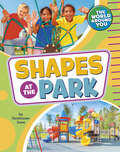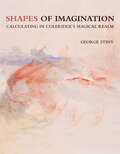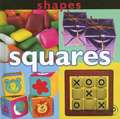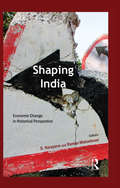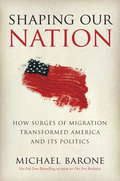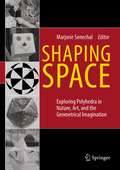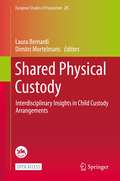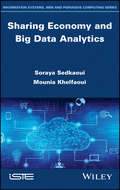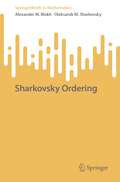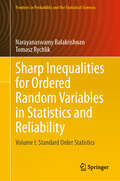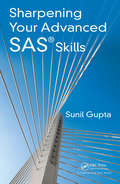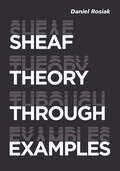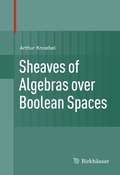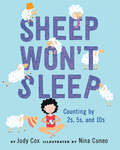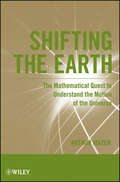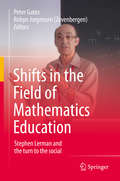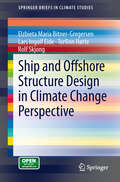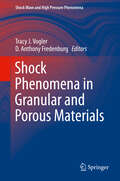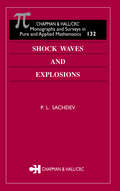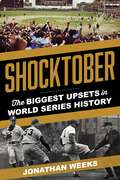- Table View
- List View
Shapes at the Park (The World Around You)
by Christianne JonesFrom rectangular ladders to circular rings and hexagonal picnic tables, the park is full of shapes! Finding shapes adds even more fun to a day at the park, and early learners will be fully engaged with the interactive, rhyming text and colorful photos in this picture book.
Shapes of Imagination: Calculating in Coleridge's Magical Realm
by George StinyVisual calculating in shape grammars aligns with art and design, bridging the gap between seeing (Coleridge's &“imagination&”) and combinatoric play (Coleridge's &“fancy&”).In Shapes of Imagination, George Stiny runs visual calculating in shape grammars through art and design—incorporating Samuel Taylor Coleridge's poetic imagination and Oscar Wilde's corollary to see things as they aren't. Many assume that calculating limits art and design to suit computers, but shape grammars rely on seeing to prove otherwise. Rules that change what they see extend calculating to overtake what computers can do, in logic and with data and learning. Shape grammars bridge the divide between seeing (Coleridge's &“imagination, or esemplastic power&”) and combinatoric play (Coleridge's &“fancy&”).Stiny shows that calculating without seeing excludes art and design. Seeing is key for calculating to augment creative activity with aesthetic insight and value. Shape grammars go by appearances, in a full-fledged aesthetic enterprise for the inconstant eye; they answer the question of what calculating would be like if Turing and von Neumann were artists instead of logicians. Art and design are calculating in all their splendid detail.
Shapes: Squares (Concepts)
by Esther SarfattiToys are square! Foods are square! Squares are everywhere! Other books by this author are available in this library.
Shaping India: Economic Change in Historical Perspective
by D. Narayana; Raman MahadevanThis volume seeks to unravel and contextualize the so-called dichotomy of ‘old’ and ‘new’ India and what binds them together. To understand this complex process, it attempts to apply a long-term historical perspective, a different conception of the economy and cross-disciplinary approaches. The exceptional feature of this volume is the large historical canvas of essays and its sensitivity to the regional dimension in a country as large and diverse as India. They deal with issues ranging from land and agriculture, entrepreneurship, industry and demographic trends to a critical anatomy of modern Indian economic historiography. Together these essays contribute in providing significantly new and enriching insights into the complex process of transition from colonial to post-colonial economic development. There has been a conscious effort in most cases to capture the influence of the colonial economic structures and processes in shaping the trajectory of growth and development in the post-independence period. Drawing upon a large amount of extremely rich and varied data and information on the socio-economic trends, the book is lucid, well-crafted and reader-friendly.
Shaping Our Nation
by Michael BaroneIt is often said that America has become culturally diverse only in the past quarter century. But from the country's beginning, cultural variety and conflict have been a centrifugal force in American politics and a crucial reason for our rise to power. The peopling of the United States is one of the most important stories of the last five hundred years, and in Shaping our Nation, bestselling author and demographics expert Michael Barone illuminates a new angle on America's rise, using a vast array of political and social data to show America is the product of a series large, unexpected mass movements--both internal and external--which typically lasted only one or two generations but in that time reshaped the nation, and created lasting tensions that were difficult to resolve. Barone highlights the surprising trends and connections between the America of today and its migrant past, such as how the areas of major Scots-Irish settlement in the years leading up to the Revolutionary War are the same areas where John McCain performed better in the 2008 election than George W. Bush did in 2004, and how in the years following the Civil War, migration across the Mason-Dixon line all but ceased until the annealing effect that the shared struggle of World War II produced. Barone also takes us all the way up to present day, showing what the surge of Hispanic migration between 1970 and 2010 means for the elections and political decisions to be made in the coming decades. Barone shows how, from the Scots-Irish influxes of the 18th century, to the Ellis Island migrations of the early 20th and the Hispanic and Asian ones of the last four decades, people have moved to America in part in order to make a better living--but more importantly, to create new communities in which they could thrive and live as they wanted. And the founders' formula of limited government, civic equality, and tolerance of religious and cultural diversity has provided a ready and useful template for not only to coping with these new cultural influences, but for prospering as a nation with cultural variety. Sweeping, thought-provoking, and ultimately hopeful, Shaping Our Nation is an unprecedented addition to our understanding of America's cultural past, with deep implications for the immigration, economic, and social policies of the future. From the Hardcover edition.
Shaping Space
by Marjorie SenechalThis second edition is based off of the very popular Shaping Space: A Polyhedral Approach, first published twenty years ago. The book is expanded and updated to include new developments, including the revolutions in visualization and model-making that the computer has wrought. Shaping Space is an exuberant, richly-illustrated, interdisciplinary guide to three-dimensional forms, focusing on the suprisingly diverse world of polyhedra. Geometry comes alive in Shaping Space, as a remarkable range of geometric ideas is explored and its centrality in our cultre is persuasively demonstrated. The book is addressed to designers, artists, architects, engineers, chemists, computer scientists, mathematicians, bioscientists, crystallographers, earth scientists, and teachers at all levels--in short, to all scholars and educators interested in, and working with, two- and three-dimensinal structures and patterns.
Shared Beginnings, Divergent Lives: Delinquent Boys to Age 70
by John H. Laub Robert J. SampsonThis book analyzes newly collected data on crime and social development up to age 70 for 500 men who were remanded to reform school in the 1940s. Born in Boston in the late 1920s and early 1930s, these men were the subjects of the classic study Unraveling Juvenile Delinquency by Sheldon and Eleanor Glueck (1950). Updating their lives at the close of the twentieth century, and connecting their adult experiences to childhood, this book is arguably the longest longitudinal study of age, crime, and the life course to date. John Laub and Robert Sampson's long-term data, combined with in-depth interviews, defy the conventional wisdom that links individual traits such as poor verbal skills, limited self-control, and difficult temperament to long-term trajectories of offending. The authors reject the idea of categorizing offenders to reveal etiologies of offending--rather, they connect variability in behavior to social context. They find that men who desisted from crime were rooted in structural routines and had strong social ties to family and community. By uniting life-history narratives with rigorous data analysis, the authors shed new light on long-term trajectories of crime and current policies of crime control.
Shared Physical Custody: Interdisciplinary Insights in Child Custody Arrangements (European Studies of Population #25)
by Laura Bernardi Dimitri MortelmansThis open access book provides an overview of the ever-growing phenomenon of children in shared physical custody thereby providing legal, psychological, family sociological and demographical insights. It describes how, despite the long evolution of broken families, only the last decade has seen a radical shift in custody arrangements for children in divorced families and the gender revolution in parenting which is taking place. The chapters have a national or cross-national perspective and address topics like prevalence and types of shared physical custody, legal frames regulating custody arrangements, stability and changes in arrangements across the life course of children, socio‐economic, psychological, social well-being of various family members involved in different custody arrangements. With the book being an interdisciplinary collaboration, it is interesting read for social scientists in demography, sociology, psychology, law and policy makers with an interest family studies and custody arrangements.
Sharing Economy and Big Data Analytics
by Soraya Sedkaoui Mounia KhelfaouiThe different facets of the sharing economy offer numerous opportunities for businesses ? particularly those that can be distinguished by their creative ideas and their ability to easily connect buyers and senders of goods and services via digital platforms. At the beginning of the growth of this economy, the advanced digital technologies generated billions of bytes of data that constitute what we call Big Data. This book underlines the facilitating role of Big Data analytics, explaining why and how data analysis algorithms can be integrated operationally, in order to extract value and to improve the practices of the sharing economy. It examines the reasons why these new techniques are necessary for businesses of this economy and proposes a series of useful applications that illustrate the use of data in the sharing ecosystem.
Sharkovsky Ordering (SpringerBriefs in Mathematics)
by Alexander M. Blokh Oleksandr M. SharkovskyThis book provides a comprehensive survey of the Sharkovsky ordering, its different aspects and its role in dynamical systems theory and applications. It addresses the coexistence of cycles for continuous interval maps and one-dimensional spaces, combinatorial dynamics on the interval and multidimensional dynamical systems. Also featured is a short chapter of personal remarks by O.M. Sharkovsky on the history of the Sharkovsky ordering, the discovery of which almost 60 years ago led to the inception of combinatorial dynamics. Now one of cornerstones of dynamics, bifurcation theory and chaos theory, the Sharkovsky ordering is an important tool for the investigation of dynamical processes in nature. Assuming only a basic mathematical background, the book will appeal to students, researchers and anyone who is interested in the subject.
Sharp Inequalities for Ordered Random Variables in Statistics and Reliability: Volume I: Standard Order Statistics (Frontiers in Probability and the Statistical Sciences)
by Narayanaswamy Balakrishnan Tomasz RychlikThe book discusses various inequalities and sharp bounds for the usual order statistics as well as some functions of them. In particular, deterministic bounds, bounds for the case of IID samples from general, symmetric and life distributions, IID samples from shape restricted family of distributions, and samples from finite populations are all discussed in detail. An elaborate numerical evaluation and comparison of various bounds are also presented in order to illustrate their inherent differences as well as their precision. Furthermore, their applications to inference, reliability theory and characterizations are also highlighted. The book provides an in-depth exposure to various mathematical inequalities and bounds established historically as well as in recent years and their applications to order statistics and some important functions of them. It thus presents an up-to-date discussion of all results in this important area of mathematical and statistical research. The results described here are general in nature and therefore could be useful in other areas of Probability and Statistics as well.
Sharpening Your Advanced SAS Skills
by Sunil GuptaSharpening Your Advanced SAS Skills presents sophisticated SAS programming techniques, procedures, and tools, such as Proc SQL, hash tables, and SAS Macro programming, for any industry. Drawing on his more than 20 years' experience of SAS programming in the pharmaceutical industry, the author provides a unique approach that empowers both advanced p
Sheaf Theory through Examples
by Daniel RosiakAn approachable introduction to elementary sheaf theory and its applications beyond pure math.Sheaves are mathematical constructions concerned with passages from local properties to global ones. They have played a fundamental role in the development of many areas of modern mathematics, yet the broad conceptual power of sheaf theory and its wide applicability to areas beyond pure math have only recently begun to be appreciated. Taking an applied category theory perspective, Sheaf Theory through Examples provides an approachable introduction to elementary sheaf theory and examines applications including n-colorings of graphs, satellite data, chess problems, Bayesian networks, self-similar groups, musical performance, complexes, and much more. With an emphasis on developing the theory via a wealth of well-motivated and vividly illustrated examples, Sheaf Theory through Examples supplements the formal development of concepts with philosophical reflections on topology, category theory, and sheaf theory, alongside a selection of advanced topics and examples that illustrate ideas like cellular sheaf cohomology, toposes, and geometric morphisms. Sheaf Theory through Examples seeks to bridge the powerful results of sheaf theory as used by mathematicians and real-world applications, while also supplementing the technical matters with a unique philosophical perspective attuned to the broader development of ideas.
Sheaves and functions modulo p: lectures on the Woods Hole trace formula
by Lenny TaelmanThe Woods Hole trace formula is a Lefschetz fixed-point theorem for coherent cohomology on algebraic varieties. It leads to a version of the sheaves-functions dictionary of Deligne, relating characteristic-p-valued functions on the rational points of varieties over finite fields to coherent modules equipped with a Frobenius structure. This book begins with a short introduction to the homological theory of crystals of Böckle and Pink with the aim of introducing the sheaves-functions dictionary as quickly as possible, illustrated with elementary examples and classical applications. Subsequently, the theory and results are expanded to include infinite coefficients, L-functions, and applications to special values of Goss L-functions and zeta functions. Based on lectures given at the Morningside Center in Beijing in 2013, this book serves as both an introduction to the Woods Hole trace formula and the sheaves-functions dictionary, and to some advanced applications on characteristic p zeta values.
Sheaves of Algebras over Boolean Spaces
by Arthur KnoebelThis unique monograph building bridges among a number of different areas of mathematics such as algebra, topology, and category theory. The author uses various tools to develop new applications of classical concepts. Detailed proofs are given for all major theorems, about half of which are completely new. Sheaves of Algebras over Boolean Spaces will take readers on a journey through sheaf theory, an important part of universal algebra. This excellent reference text is suitable for graduate students, researchers, and those who wish to learn about sheaves of algebras.
Sheep Won't Sleep: Counting by 2s, 5s, and 10s
by Judy CoxCounting sheep is supposed to help you sleep—but a room full of yaks, alpacas, and llamas would keep anyone awake in this counting book with a comical twist. Winner of the Mathical Book Prize! A glass of warm milk, reading, working on her knitting—nothing can help Clarissa get to sleep. When even counting sheep doesn't help her doze off, she tried pairs of alpacas instead. Two, four, six . . . then llamas by fives . . . then yaks by tens! But no one could sleep with a room full of bouncing, bleating, shedding animals. Determined to unravel her problem so she can get some sleep, Clarissa counts back down until she's all alone, and she can finally get some rest. Introducing addition and subtraction by ones, twos, fives, and tens, Sheep Won't Sleep is part bedtime story, part math practice— and the hilarious illustrations of spotted, striped, and plaid animals are sure to appeal to imaginative readers of all ages. A perfect-- and fun!-- way to introduce and reinforce counting in groups, this is sure to be a study- and bedtime favorite!
Shifting the Earth
by Arthur MazerDiscover how mathematics and science have propelled history From Ancient Greece to the Enlightenment and then on to modern times, Shifting the Earth: The Mathematical Quest to Understand the Motion of the Universe takes readers on a journey motivated by the desire to understand the universe and the motion of the heavens. The author presents a thought-provoking depiction of the sociopolitical environment in which some of the most prominent scientists in history lived and then provides a mathematical account of their contributions. From Eudoxus to Einstein, this fascinating book describes how, beginning in ancient times, pioneers in the sciences and mathematics have dramatically changed our vision of who we are as well as our place in the universe. Readers will discover how Ptolemy's geocentric model evolved into Kepler's heliocentric model, with Copernicus as the critical intermediary. The author explains how one scientific breakthrough set the stage for the next one, and he also places the scientists and their discoveries within the context of history, including: Archimedes, Apollonius, and the Punic Wars Ptolemy and the rise of Christianity Copernicus and the Renaissance Kepler and the Counter-Reformation Newton and the Enlightenment Einstein and the detonation of the atom bomb Each chapter presents the work of a single scientist or mathematician, building on the previous chapters to demonstrate the evolutionary process of discovery. Chapters begin with a narrative section and conclude with a mathematical presentation of one of the scientist's original works. Most of these mathematical presentations, including the section on Einstein's special relativity, are accessible using only basic mathematics; however, readers can skip the mathematical sections and still follow the evolution of science and mathematics. Shifting the Earth is an excellent book for anyone interested in the history of mathematics and how the quest to understand the motion of the heavens has influenced the broader history of humankind.
Shifts in the Field of Mathematics Education
by Peter Gates Robyn JorgensenProfessor Stephen Lerman has been a leader in the field of mathematics education for thirty years. His work is extensive, making many significant contributions to a number of key areas of research. Stephen retired from South Bank University in 2012, where he had worked for over 20 years, though he continues to work at Loughborough University. In this book several of his long standing colleagues and collaborators reflect on his contribution to mathematics education, and in so doing illustrate how some of Steve's ideas and interventions have resulted in significant shifts in the domain.
Shimura Varieties (London Mathematical Society Lecture Note Series #457)
by Michael Harris Thomas HainesThis is the second volume of a series of mainly expository articles on the arithmetic theory of automorphic forms. It forms a sequel to On the Stabilization of the Trace Formula published in 2011. The books are intended primarily for two groups of readers: those interested in the structure of automorphic forms on reductive groups over number fields, and specifically in qualitative information on multiplicities of automorphic representations; and those interested in the classification of I-adic representations of Galois groups of number fields. Langlands' conjectures elaborate on the notion that these two problems overlap considerably. These volumes present convincing evidence supporting this, clearly and succinctly enough that readers can pass with minimal effort between the two points of view. Over a decade's worth of progress toward the stabilization of the Arthur-Selberg trace formula, culminating in Ngo Bau Chau's proof of the Fundamental Lemma, makes this series timely.
Ship and Offshore Structure Design in Climate Change Perspective (SpringerBriefs in Climate Studies)
by Rolf Skjong Elzbieta Maria Bitner-Gregersen Tor Svensen Lars Ingolf Eide Torfinn HørteThis book summarizes results of longstanding research and scientific contributions from many projects and relevant working groups. It collects and evaluates wind and wave climate projections under changing climate having design needs and marine safety in focus. Potential impact of projected climate change in met-ocean conditions on ships and offshore structures is discussed and illustrated by an example of the expected wave climate change on tanker design. The monograph is intended for students, researchers and industry based engineers who want a summary of the many studies that have been carried out on climate change effects on wind and waves and their importance for design and operations of ship and offshore structures. The reader needs only a moderate knowledge of marine wind and wave climate to follow the text.
Shock Phenomena in Granular and Porous Materials (Shock Wave and High Pressure Phenomena)
by Tracy J. Vogler D. Anthony FredenburgGranular forms of common materials such as metals and ceramics, sands and soils, porous energetic materials (explosives, reactive mixtures), and foams exhibit interesting behaviors due to their heterogeneity and critical length scale, typically commensurate with the grain or pore size. Under extreme conditions of impact, granular and porous materials display highly localized phenomena such as fracture, inelastic deformation, and the closure of voids, which in turn strongly influence the bulk response. Due to the complex nature of these interactions and the short time scales involved, computational methods have proven to be powerful tools to investigate these phenomena. Thus, the coupled use of experiment, theory, and simulation is critical to advancing our understanding of shock processes in initially porous and granular materials. This is a comprehensive volume on granular and porous materials for researchers working in the area of shock and impact physics. The book is divided into three sections, where the first presents the fundamentals of shock physics as it pertains to the equation of state, compaction, and strength properties of porous materials. Building on these fundamentals, the next section examines several applications where dynamic processes involving initially porous materials are prevalent, focusing on the areas of penetration, planetary impact, and reactive munitions. The final section provides a look at emerging areas in the field, where the expansion of experimental and computational capabilities are opening the door for new opportunities in the areas of advanced light sources, molecular dynamics modeling, and additively manufactured porous structures. By intermixing experiment, theory, and simulation throughout, this book serves as an excellent, up-to-date desk reference for those in the field of shock compression science of porous and granular materials.
Shock Waves & Explosions (Monographs and Surveys in Pure and Applied Mathematics)
by P.L. SachdevUnderstanding the causes and effects of explosions is important to experts in a broad range of disciplines, including the military, industrial and environmental research, aeronautic engineering, and applied mathematics. Offering an introductory review of historic research, Shock Waves and Explosions brings analytic and computational methods
Shocktober: The Biggest Upsets in World Series History
by Jonathan WeeksBaseball&’s October showcase has provided some high drama over the years. Willie Mays&’s spectacular catch in 1954, Bill Mazeroski&’s walk-off homer in 1960, and Kirk Gibson&’s pinch-hit blast in 1988 are just a few of the memorable moments that have dominated highlight reels. The outcome of the Series has not always been terribly surprising—especially during the late 1940s and early 1950s when the Yankees captured five consecutive championships, breaking their previous record of four straight titles from 1936 to 1939. But in spite of its predictability at times, the Fall Classic has taken many unexpected turns. The 1906 Cubs lost to the weak-hitting White Sox after establishing a new regular season record for wins. The 1955 Dodgers avenged seven prior October failures with an improbable victory over the seemingly invincible Yankees. And in 1969, the Mets finally shed their image as &“loveable losers,&” dethroning the powerful Orioles. In more than a century of World Series plays, a number of similar scenarios have emerged. Twenty-two of those stories are told in Shocktober. The book also includes an appendix of game statistics as well as a section on World Series trivia.
Shohei Ohtani: The Amazing Story of Baseball's Two-Way Japanese Superstar
by Jay ParisRarely does anyone use the term “two-way” in regard to a baseball player. Yet the Los Angeles Angels’ Shohei Ohtani, at the young age of twenty-three, has become the epitome of the term, drawing comparisons to Babe Ruth by baseball pundits everywhere. After being drafted by the Hokkaido Nippon-Ham Fighters of the Japan Pacific League with the number-one pick in 2012, the eighteen-year-old Ohtani struggled with the bat during his rookie season. However, he had a breakout year in 2014, posting a 2.61 ERA in 24 starts and 179 strikeouts (as well as 10 home runs). By 2017, all thirty Major League Baseball teams had heard about the Japanese phenom and expressed interest in signing him. Ultimately, the Angels offered him the opportunity to compete as a two-way player and the chance to accomplish his professional goals. After a quiet spring training, Ohtani broke out in the first two weeks of the 2018 regular season, becoming just the 14th pitcher in major-league history to strike out 12 batters in one of his first two starts. He also homered in three consecutive games during that stretch. Shohei Ohtani: The Amazing Story of Baseball’s Two-Way Japanese Superstar tells the story of the player from rural Japan who became a two-way star not seen in America since Babe Ruth. With highlights of his best games on the mound and at bat from each month of his rookie season and anecdotes of his life in America, this is the one book that every fan will want.
